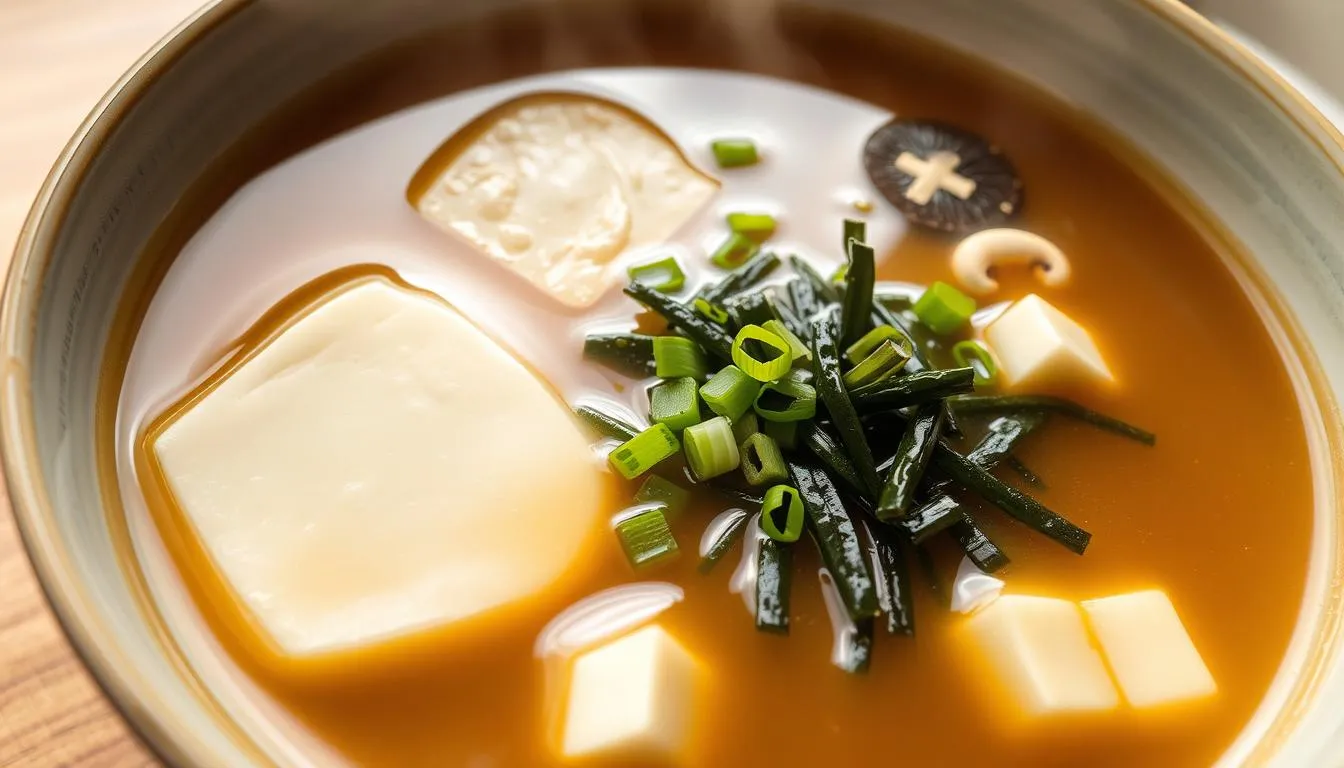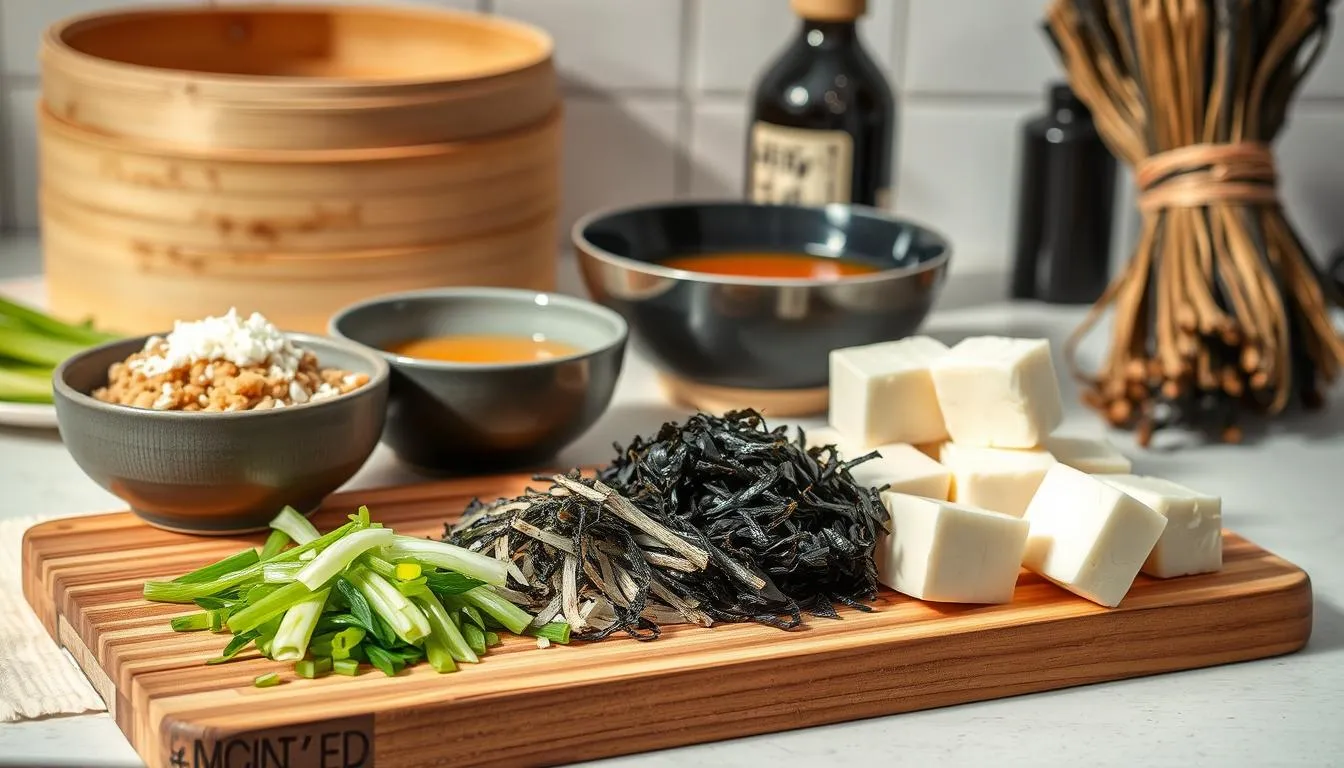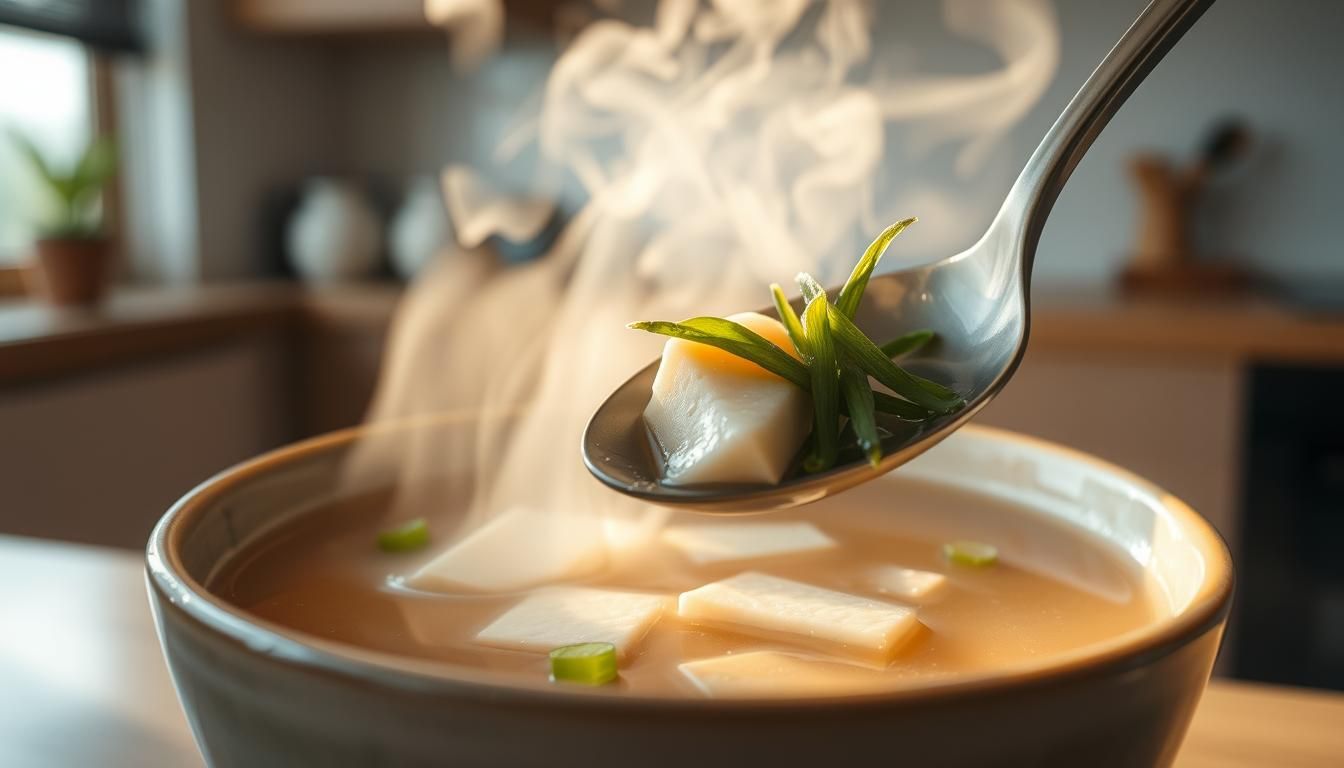There are evenings when all you want is a warm bowl that feels like home. I remember the first time I made this dish for a tired weeknight — simple ingredients, a quiet kitchen, and the comforting aroma that filled the room.
This guide sets the stage for an approachable, pantry-friendly method to make a deeply savory Japanese favorite fast, without losing authenticity. You’ll meet the core building blocks: miso paste, dashi, silken tofu, and wakame, and learn why each one matters to the final flavor.
With smart shortcuts like Hondashi, you can go from craving to sipping in under 20 minutes. I’ll also show easy techniques to keep the broth smooth, how to dissolve miso properly, and why keeping the pot below 203°F/95°C protects aroma and beneficial probiotics.
Whether you prefer delicate white or bold red, this friendly recipe is forgiving and repeatable. Expect tips for quick add-ins, storage, and reheating so leftovers taste great the next day. For a classic reference on traditional dashi and technique, see a trusted classic miso soup recipe.
Key Takeaways
- Core ingredients: miso paste, dashi, silken tofu, wakame seaweed.
- Keep broth under 203°F/95°C to protect aroma and probiotics.
- Hondashi instant dashi saves time for weekday meals.
- Match white or red base to your desired flavor and pairing.
- Technique tips keep the broth smooth and tofu intact.
- Quick add-ins make it a snack, side, or light main.
Why this Japanese miso soup recipe is simple, flavorful, and perfect for busy weeknights
Weeknights get easier when a classic, sea-scented broth comes together in one pot. This method gives you an authentic bowl without long prep or obscure steps.

User intent and what you’ll learn today
You want a reliable, weeknight-friendly approach that still tastes true to japanese miso tradition. I will show fast, pantry-based recipes, when to use instant dashi, and how to protect delicate aroma with gentle heat.
What makes authentic miso soup comforting yet fast
Two dashi paths let you choose speed or depth. Instant Hondashi saves time. Traditional stock from kombu and bonito flakes gives a cleaner, sea-forward broth.
Keep the pot under a boil; staying below 203°F/95°C preserves aroma and nutrients. Serve around 167°F/75°C for ideal sipping.
- Wakame hydrates in minutes for oceanic aroma and a subtle chew.
- Silken tofu adds soft protein and a restaurant-style texture.
- One-pot prep and minimal cleanup mean dinner is done in minutes.
| Option | Time | Best for |
|---|---|---|
| Instant dashi (Hondashi) | 2–3 minutes | Fast weeknights, consistent umami |
| Traditional kombu + bonito flakes | 15–20 minutes | Purists, cleaner sea flavor |
| Simple pantry broth + miso paste | 5–10 minutes | Flexible, quick adaptations |
Next up: shopping for the right paste, dissolving techniques, and tips to add tofu and seaweed without breaking the texture.
Ingredients for classic miso soup with silken tofu and seaweed
Gathering the right pantry items makes a fast, restaurant-feel bowl possible any night.
 Choose your paste: white miso (shiro) is mild and slightly sweet, yellow sits between, and red (aka) gives a bold, savory backbone. Each shifts color and intensity in the broth.
Choose your paste: white miso (shiro) is mild and slightly sweet, yellow sits between, and red (aka) gives a bold, savory backbone. Each shifts color and intensity in the broth.
Miso paste 101
Buy paste kept refrigerated for freshness. Use a small amount at first; you can always add more to adjust salt and depth.
Dashi options
For clarity and tradition, soak kombu then steep katsuobushi (bonito flakes). If time is tight, instant Hondashi granules dissolve immediately and save minutes.
Tofu and wakame
Silken tofu stays creamy and tender in hot liquid, but soft or firm tofu work as substitutes. Tofu brings lean protein with low fat.
Use thick dried wakame rather than roasted sheets. A teaspoon rehydrates in about three minutes and expands, adding umami and iodine.
Finishing touches and boosters
- Thinly sliced scallions for brightness.
- Optional boosters: a dab of chicken bouillon paste for body or a lightly beaten egg for extra protein.
- Check nutrition: wakame adds trace vitamins and a bit of fiber.
Plan ahead: measure ingredients before you start so the recipe moves in minutes and stays weeknight-friendly.
Step-by-step: from dashi to bowl in minutes
Follow these focused steps to move from broth to bowl in under twenty minutes. Begin with four cups of water heated gently in a medium pot so the broth stays clean and bright.

Make the broth: water, dashi, gentle heat
Add 2 teaspoons of dashi granules to the hot water and stir until dissolved. Keep the liquid hot but avoid a rolling boil. A gentle heat preserves a clean, balanced base.
Rehydrate wakame and set aside
Place dried wakame in a small bowl of hot water for about three minutes. Drain and set aside. This prevents over-softening once it joins the main pot.
Add tofu without breaking
Gently cut silken tofu into cubes or spoon soft chunks. Slide them into the broth and nudge lightly with a spoon so they stay intact.
How to add miso paste correctly
To add miso, place paste in a small strainer and suspend it in the hot broth. Stir with a spoon until smooth. This prevents clumps and protects the delicate texture of the tofu.
Ideal temperature tips
Aim for a low simmer at most. Keep the temperature below 203°F/95°C and turn heat off before the liquid reaches a full boil. This keeps aroma and nutrients vibrant.
Finish and serve
Add sliced scallions at the end for a fresh lift. Ladle into warm bowls and serve immediately to enjoy the best flavor and texture. Make sure the bowl is warm so the broth stays inviting.
Pro tips for maximum flavor in minimal time
A few pro moves will make each bowl taste deeper without adding time.
Choose the right profile: white offers mild sweetness, yellow sits between, and red brings robust umami. Pick paste to match the meal — white with gentle fish or red for grilled mains.
Smart dissolving and heat control
To prevent cloudy clumps, dissolve miso paste in a ladle or fine strainer with a scoop of hot broth. Press gently so the paste disperses evenly before it meets the main pot.
Keep the pot under a low simmer; control of temperature and heat preserves aroma and stops bitterness. Turn off the flame just before a boil.
“Small handling changes — the right paste and gentle heat — create a clearer, rounder broth fast.”
- Use instant dashi for speed or bloom kombu in water and steep bonito flakes if you have a few extra minutes.
- Make sure wakame is fully hydrated and drained before adding.
- Let tofu rest briefly in hot broth (not boiling) so it soaks flavor without falling apart.
| Tip | Why it helps | Time impact |
|---|---|---|
| Match paste to menu | Balances flavor with other dishes | 0 minutes |
| Dissolve in ladle/strainer | Prevents lumps and cloudiness | 1–2 minutes |
| Kombu + bonito steep | Adds clear umami depth | 5–15 minutes |
Always taste and add miso paste a little at a time until the soup is balanced. For a quick, tested method, try this 15-minute miso soup.
Tasty variations and add-ins to customize your bowl
A few simple add-ins can change this classic into a full meal or a cozy snack.
Egg-drop for extra comfort: Keep the broth at a low simmer. Pour lightly beaten eggs in a thin stream without stirring to form delicate ribbons. Let them set a few seconds before nudging gently.
Turn it into a light meal
Add noodles—udon, soba, or thin wheat—near the end so they warm through in a minute or two. This makes the bowl more filling while keeping the clear taste of the base.
Vegan-friendly swaps
Replace fish dashi or chicken stock with mushroom powder or a rich vegetable stock. Combine with japanese miso paste for deep umami and avoid animal products.
- Finish with a few drops of chili oil or a pinch of flakes for controlled heat.
- Add tofu after seasoning so it warms through without breaking.
- Layer wakame and a small piece of kombu in the pot if you want extra sea notes.
- For a chicken-forward boost, a little bouillon paste adds body without masking delicate taste.
- Finish with scallions right before serving to keep them bright and aromatic.
Storage, reheating, and meal prep
A fast chill and gentle reheating are the secrets to keeping flavor and texture intact. Cool the pot briefly, then move the broth into a shallow container and refrigerate. Aim to use leftovers within a few days for best taste and texture.
Quick guidelines for fridge-to-bowl results
Reheat gently: warm the bowl on low heat or use short microwave bursts. Stop before a full boil so the miso aroma stays bright.
Add scallions after warming so they stay fresh. If the broth thickens, stir in a splash of water to restore a light, sippable texture.
- Let the pot cool, then set aside into containers and chill.
- Seaweed continues to hydrate—avoid prolonged reheating; heat just until steaming.
- Portion into single-serve jars for fast lunches that take minutes to heat.
Nutrition note: wakame adds trace vitamin and a bit of fiber, while the base remains light. Keep cooked rice or prepped toppings on hand to round out a quick meal without extra time in the kitchen.
Cooking miso soup
A calm, step-by-step routine keeps textures intact and flavor balanced every time.
Add 4 cups of water to a medium pot and warm it over low heat. Dissolve 2 teaspoons of dashi granules, keeping the liquid at a gentle steam rather than a rolling boil.
Hydrate a small pinch of wakame in hot water for about 3 minutes, drain well, and add it to the pot with cubed silken tofu. Turn the heat off before you add the paste.
Make sure to dissolve the miso paste in a strainer or ladle using a bit of hot broth. Swirl the smooth mixture back into the pot and stir gently so the cubes stay whole.
- Keep below 203°F/95°C so aroma and nutrients stay bright.
- Taste and add a touch more miso if needed, then ladle into a warm bowl.
- Finish with sliced scallions and serve right away — you’re ready in just a few minutes.
This baseline method adapts easily: swap in a kombu-based broth, tweak seasoning to your taste, or scale up for meal prep without changing the steps.
Conclusion
In just a few focused steps you can turn basic pantry items into a comforting, umami-rich bowl. Use either kombu-and-bonito dashi or instant Hondashi, hydrate wakame, and handle silken tofu gently for the classic look and mouthfeel.
Keep the flow: heat the water in a pot on low, season the broth with dashi, add tofu and seaweed, turn heat off, then whisk in paste off the boil. Aim for a low simmer and serve warm, not boiling, to protect aroma and flavor.
With these small techniques you’ll save time, control fat and salt, and scale the recipe for meal prep. This approach makes reliable miso soup that fits weeknights and pairs well with any main.
FAQ
What type of paste should I use for an easy, authentic bowl?
Use white (shiro) paste for a mild, slightly sweet profile that fits weeknight meals. Yellow adds more depth, and red (aka) gives a robust, salty finish. Choose based on how strong you want the flavor and pair with lighter or heartier dishes.
How do I make the broth quickly without bonito flakes?
Use instant dashi granules or low-sodium chicken bouillon dissolved in hot water. For a vegan option, steep dried shiitake or kombu in warm water for 10–20 minutes and strain for a savory base.
When should I add silken tofu so it stays intact?
Cube or spoon in the tofu after the broth reaches a gentle simmer and remove from direct heat. This prevents breaking and keeps a smooth texture. Let the pot rest briefly before serving.
What’s the right way to dissolve the paste without clumps?
Scoop paste into a small bowl, add a ladle of warm broth, whisk until smooth, then return to the pot off the heat. Alternatively, press paste through a fine mesh strainer into the broth for even distribution.
How hot can the liquid get without ruining flavor?
Keep temperature below 203°F (95°C) and avoid boiling once the paste is added. High heat kills delicate aroma and probiotics in the paste, so use a low simmer to preserve taste.
Can I add eggs or noodles to make it more filling?
Yes. For an egg drop, slowly stream beaten egg into gently simmering broth while stirring. Add quick-cooking noodles near the end and warm through. Adjust seasoning if you add salty ingredients.
How long does a prepared batch last in the refrigerator?
Store in an airtight container for up to 3–4 days. Keep the tofu and seaweed submerged in the broth to retain moisture. Reheat gently on low heat and avoid boiling after reheating.
Can I freeze the broth or the whole bowl?
Freeze the broth without tofu or fresh scallions for up to 2 months. Tofu can become watery and grainy after freezing, so add fresh tofu when reheating.
How do I rehydrate wakame so it’s not too soft?
Soak wakame in cool water for 5–10 minutes, then drain and squeeze out excess liquid. Add to the bowl just before serving so it keeps a pleasant, slightly chewy texture.
Are there quick hacks to boost umami fast?
Add a small pinch of bonito flakes to the broth while simmering, a splash of soy sauce, or a few drops of sesame oil at the end. Dried mushrooms or a light smear of fermented bean paste also deepen flavor.
How much paste per cup of broth should I use?
A general guideline is about 1 teaspoon per cup of broth, but start conservatively and taste. White paste requires slightly more than red for the same intensity, so adjust to preference.
Can I use store-bought stocks like chicken or vegetable?
Yes. Low-sodium chicken or vegetable stock makes a quick, flavorful base. Reduce added salt and taste before adding paste to avoid an overly salty bowl.
How do I keep scallions bright and aromatic?
Slice scallions thin and add them off the heat, just before serving. This preserves their color, crunch, and fresh bite without wilting.
